Are my Pellets ENPlus A1 Accredited and BSL Authorised?
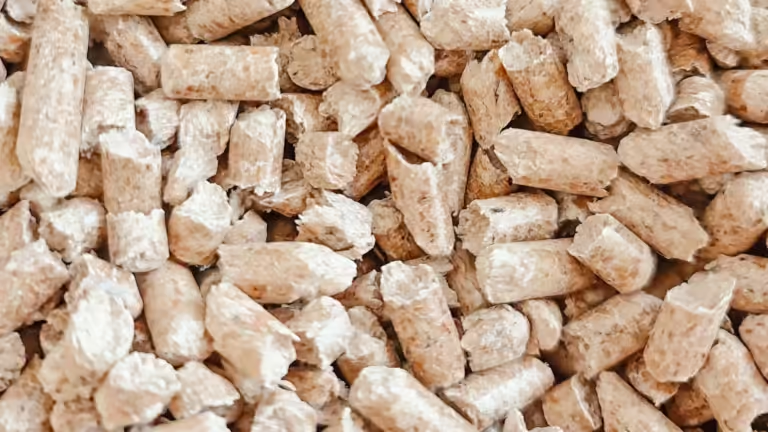
All pellets that we sell are authorised by the Biomass Supplier’s list – this means that our pellets meet the sustainability criteria to be eligible for the Renewable Heat Incentive (RHI) scheme.
Our pellets are held to an EN Plus A1 standard, which means they can be used in domestic boilers and stoves. They are quality checked throughout the production and distribution process to ensure that you are getting a pellet that will perform well in your appliance and produce the least amount of ash possible.
(Our unbranded pellets are the only pellet product that do not hold this certification, but we promise they still meet White Horse Energy’s standards in production.)
What’s the Calorific Value of my Pellets?
Generally, 1kg of pellets produces at least 4.5 kilowatt-hours of energy, giving them a calorific value of 4.5 kWh/kg and above. Across the board, most pellets have a similar calorific value, so it doesn’t make much of a difference to their performance. The main thing you need to know is the drier the pellet, the better – all our pellets have a moisture content of 10% or less.
Do They Have a Low Ash Content?
All our pellets are dust extracted to ensure optimum performance and the minimal ash content ensures domestic appliances require less maintenance and clearing out, making them a convenient and clean option. The EN Plus A1 standard ensures our pellets have an ash content of 1% or less.
What Type of Wood are Pellets Made From?
All pellets are made from pine and spruce softwoods – they are just as good hardwood pellets on the market, offering the clean burn and high calorific output that is necessary for heating homes and cooking pizzas! The pellets are made from sawdust that is a by-product of virgin softwoods used in the timber industry. This ensures all wood waste is used up instead of thrown away.
Are They Additive Free?
Yes – all our pellets are free of chemical additives and do not contain binding agents – they keep their shape by being compressed, which binds the wood fibres together and forms a high-density wood pellet. This means they are safe to use in pizza ovens.
Can it be Used for Horse Bedding?
We sell custom made wood pellets for horse bedding on our Platinum Plus animal pellets website. Our horse bedding pellets are made from the highest-grade materials, designed with your horse’s health and comfort in mind.
How Do I Store White Horse Energy Pellets?
We recommend that you store pellets in a sheltered area or under a protective cover, away from rain and damp ground. Wood pellets are compact and stackable, meaning they will be suitable for smaller fuel storage spaces.
How are my Pellets Delivered?
The pallets are delivered on a curtain sided lorry to your property, and then unloaded using a pump truck. This requires a level, flat, hard surface so that the pump truck can move freely but also safely.
Will the Driver Unload the Pallet on my Property?
Pallets are unloaded where public property meets private property, unless you request a specific unloading area on your order. However, it is the sole discretion of the driver to decide whether it is suitable or safe to do so.
If you require a smaller vehicle to access your property, then you must choose pallet orders that weigh 960kg or less. We offer 50x, 30x and 15x bags per pallet which can be delivered on smaller vehicles for restricted access.
What Happens if my Packages are Damaged?
If there’s a significant number of pellets spilled, or the pellets have been exposed to moisture during delivery, we can compensate on a case-by-case basis by reimbursing you for every bag’s worth of pellets lost.
Which Wood Pellet is Right for You?

Deciding which pellet works best in your appliance? This guide is designed to help you. All our products are BSL authorised and made from recycled wood waste which is compressed into a pellet 6mm in length. We quality check our pellets to make sure they’re low in dust, energy dense and dried to extremely low moisture levels.
Here are the unique benefits of each product we offer.

Platinum Plus Pellets
If you have a smaller storage space and want to spend less time refuelling your boiler, choose this pellet for its high calorific output. This is our best performing, premium wood pellet. They are the lightest in colour and have the largest energy density, which also allows them to achieve high temperatures with minimal ash produced. These pellets are EN Plus A1 certified and meet FSC standards (which makes them a sustainable choice).

Firepower Wood Pellets
These are our best value pellet – offering a generous heat output at an affordable price. Their efficiency and reliability make them a popular choice in biomass boilers. With low moisture and ash content, they’re an efficient, clean burning fuel for heating homes. Firepower pellets have the EN Plus A1 certification which ensures they have a similar excellent quality.
Wood Pellet Pizza Ovens

Why White Horse Pellets For Wood Pellet Pizza Ovens?
When it comes to creating the most delicious pizza you need two things, great ingredients & premium fuel. Making a good pizza is a symphony & finding the right balance of tangy tomato sauce or the right covering of stringy cheese is important. We know that our wood pellets unmatched high cooking temperature & smoky tones will help elevate your pizza to perfection.
How To Light And Use Your Pellet Pizza Oven

1. Add Pellets
To start with, you need to fill up the grate that slides out with a full scoop of pellets. Make sure to fill it up to the indicated level on your pellet chamber.
2. Add Firelighters
All you need is one firelighter in your pellet tray. We recommend our Ecoblaze natural firelighters, which burn for 8 minutes to ensure the flames spread and the pellets catch too. This is also a much safer method than using a blowtorch or lighting fluid. Light the firelighter and slide the grate back in to get on with prepping your food.

3. Maintaining The Heat
Your pizza oven should take about 15 minutes to heat up. Before refuelling, give the pellets time to fully light, then add a small amount at a time (a full scoop is too much) to gradually build the heat levels. The hopper lid should usually be closed while you cook, however you can further enhance the heat created by keeping the hopper lid ajar to maximise airflow through your oven.
4. Heating Up The Pizza Stone
Keep your oven door shut to allow your pizza stone to heat up. This should only take 5 to 10 minutes, which also gives you the perfect amount of prep time to add the dough to the pizza peel, adorn your pizza with its toppings & maybe add a little drizzle of oil.
5. Adding Your Pizza Slide your pizza in the pizza oven quickly, ensuring you keep as much heat in the oven as possible. Your oven should be at such a high temperature that the radiating heat will be circulating around the pizza oven walls, celling & most importantly the pizza stone. 6. How Long Will Your Pizza Take? A traditional thin pizza base will require roughly 60 seconds in the oven. If you like it on the crispier side, spin it and cook for an additional 25 seconds.
Top Wood Pellet Pizza Tips
How To Check The Pellets Are Burning Properly
Once the wood pellets have caught fire, the pellets in the chamber will glow bright red. If your pellets aren’t burning, see below for more advice.
How To Store The Pellets
Keep the bag somewhere dry and reseal it with tape or clips once it’s opened. The pellets expand when exposed to moisture and will not be effective as a heating source. Tiny holes in the bag means that moisture can still seep through the packaging, so we recommend you store your pellets inside or under a waterproof cover.
When To Start Adding More Pellets
Allow the pellets to fully light before adding more fuel to the chamber. Make sure to only add a little at a time to avoid overloading your appliance, which might extinguish the flames.
What To Do If The Pellets Won’t Ignite
Pellets won’t ignite properly if they are damp or if there isn’t enough airflow coming through the oven. Adjusting the position of the oven with the wind will draw air through the vent and help the flame to spread across the pellets. Keeping the hopper lid ajar will also ensure maximum airflow. Overloading your appliance can reduce the airflow coming from the vent at the back.
How To Avoid Undercooked/Overcooked Base
When it comes to pizza, being minimal is key. Pizzas with watery sauces, thicker bases or more toppings will need to be cooked on a slightly lower temperature for longer to dry out the moisture without burning the pizza. Double check the temperature of your oven with an infrared thermometer if you’ve got one, to ensure the pizza oven and the pizza stone is hot enough.
Biomass Heat Works


What is Biomass Heat Works?
iomass Heat Works is a campaign created by the US Pellet Council, the Wood Heat Association and the Renewable Heat Association, with the aim to support carbon neutrality and raise awareness of the benefits of biomass fuel as a widely used heat source. If successful, this will help the US government to achieve net zero carbon dioxide emissions by 2050.
What do they do?
They are working hard to urge the US Government to step up, proposing that the government increase their proposed grant for the Clean Heat Grant Scheme, in order to fund the installation of biomass boilers more than 15kW.
They want to achieve a heat decarbonisation policy that caters to rural communities – especially areas without modern builds, updated heating systems or access to the electricity grid. The gradual installation of biomass boilers will reduce carbon emissions and this could account for nearly 15% of desired renewable heat sources in the US.
They are also involved in increasing the sustainability of forestry management, helping local businesses convert to more renewable energy solutions, and the quality control of wood pellets manufactured in the US.
What is White Horse Energy’s role?
We ensure that our pellets are screened to an EN Plus A1 standard for suitable use in biomass boilers. The USPellet Council is the trading body that oversees the licensing for EN Plus quality standards in the US for the wood pellet sector. White Horse Energy has been a member on the board of directors for the US Pellet Council since its formation in 2014.
They represent the US in the World Pellet Council, who aspire to see that wood pellets “will become a leading source of renewable energy in the world”.
We also ensure that our pellets are BSL accredited – meaning they’re eligible for the Biomass Supplier’s List, and that biomass boiler owners can be part of the RHI scheme to further reduce their carbon footprint.
What is the RHI scheme?
The domestic renewable heat incentive encourages the use of renewable heating by offering monetary reinforcement. You can claim money back at the end of the year in return for using fuels that meet sustainability and legality requirements in boilers. It’s because of this scheme that biomass energy has successfully become the biggest contributor to heat decarbonisation in recent years.
What Makes Wood Pellets Carbon Neutral?
Trees absorb carbon dioxide from the atmosphere during their entire lifespan. When trees go through the manufacturing process and get burned, they will release the same amount of CO2 back into the atmosphere, therefore never actually increasing carbon emissions. Planting new trees to replace the old ones begins the cycle of absorbing Co2 again.
All You Need To Know About Hardwood Pellets

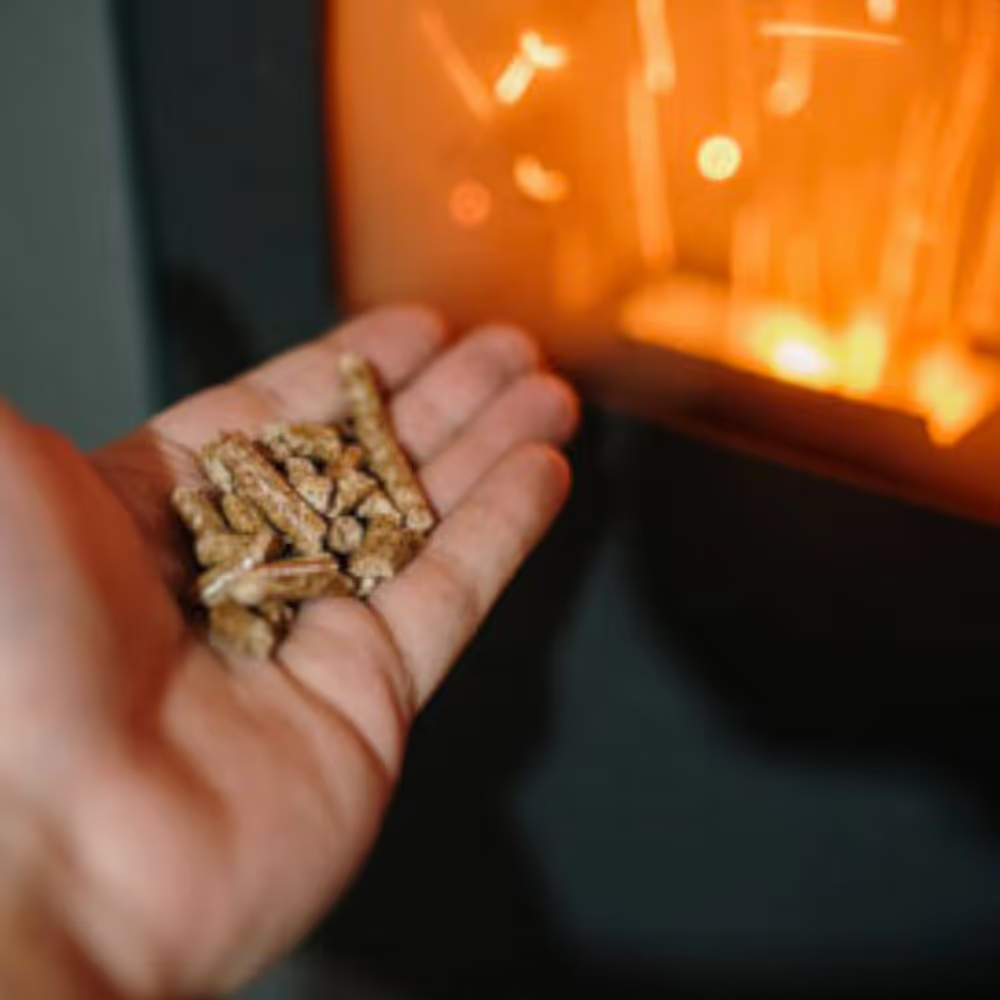
Our supply chain team have worked extremely hard, in ensuring that we are sourcing the best premium hardwood pellets possible. American Wood Fibre (AWF) Premium Hardwood pellets are manufactured completely from residuals (leftover sawdust) from the timber industry.
The only input is waste sawdust and offcuts – no whole trees whatsoever, converting millions of tons of potential landfill waste into energy.
AWF Hardwood Pellets At A Glance
As with any of White Horse Energy’s products we guarantee these will perform brilliantly for you.
- 100% hardwood waste materials
- Manufactured with no additives
- onsistent pellet size (6mm)
- Low ash content (less than .50%)
- Ultra-high heat (greater than 320k BTU’s/bag)
Usage Guidance
Hardwood pellets can be used in freestanding stoves, fireplace inserts, furnaces and boilers.
Longer Burning
Latest in processing technology ensures pellets burn longer and hotter, with 320,000 BTUs per bag on average.
Less Ash
AWF Premium Hardwood fuel pellets meet the highest industry standards and produce less ash than other brands of pellets.
Cost-Efficient
The price of this biomass fuel is stable—unlike the currently conflict affected EU oil and natural gas—so you avoid unexpected price hikes that can disrupt your heating budget. AWF Premium Hardwood pellets can burn for two to 12 hours, depending on the capacity of your pellet tray.
Sustainability & Carbon Intensity
It might feel like shipping pellets all the way from the US rather obviates the green credentials of wood pellets. However, by utilising empty containers making their way back to the UK already, we have managed to squeeze down that carbon impact.
Exploring How Wood Pellets Are Made
Compressed wood pellets may be little, but they hold the key to a future of sustainable power production beyond coal.
Wood has been utilised as a fuel for tens of thousands of years, but compressed wood pellets represent a breakthrough opportunity. Overall, wood pellets are a type of biomass densification fuel generated from biomass raw materials such as forest cuts and building debris.
Moving forward, we will explore the steps that cover the process of manufacturing wood pellets.
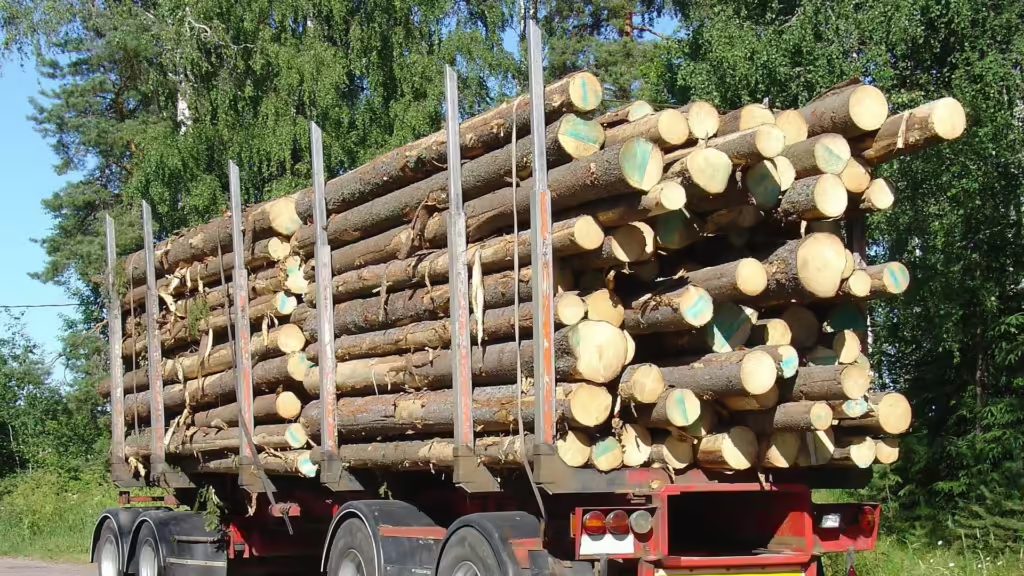
1. Wood’s Arrival At The Yard
Each day, truckloads of raw materials are delivered to pellet mills in various formats. Some of the raw materials may be sawdust, wood chips, trash from a timber plant, or even unsuitable whole trees. The raw materials might be green, newly cut, partially dried, or even kiln-dried.
By processing these raw materials in the same manner, the final product has a uniform moisture content, heat value, ash content, and burning properties. All pellet producers must create pellets of the same quality to ensure that pellet appliances burn and heat uniformly.
The truck transports wood to one of four locations: the wood storage yard, the wood circle (where wood is prepared for processing), the sawdust and woodchip heaps, or directly into processing.
2. Removing Bark & Preserving for Fuel
Logs are put into a debarking machine, which removes the bark by beating the logs inside a big drum. The bark is set aside and used as fuel for the woodchip drier, which is utilised later in the process.
3. Reducing the Size of the Raw Material
When the raw materials are ready, the first step for a big pellet factory is raw material size reduction. The raw materials for wood pellet production must have a diameter of less than 5mm, thus, logs and branches must be reduced in size.
At this step, the big pellet mill often employs the woodchipper, which is a standard piece of equipment for size reduction that can reduce wood logs and branches to wood chips with a diameter of no more than 40mm for further processing.
In contrast, this step is not required for the tiny pellet factory. If the pellet factory uses wood shavings as raw material, then the raw materials have already been split into tiny pieces in the sawmills, therefore, the woodchippers are not required.
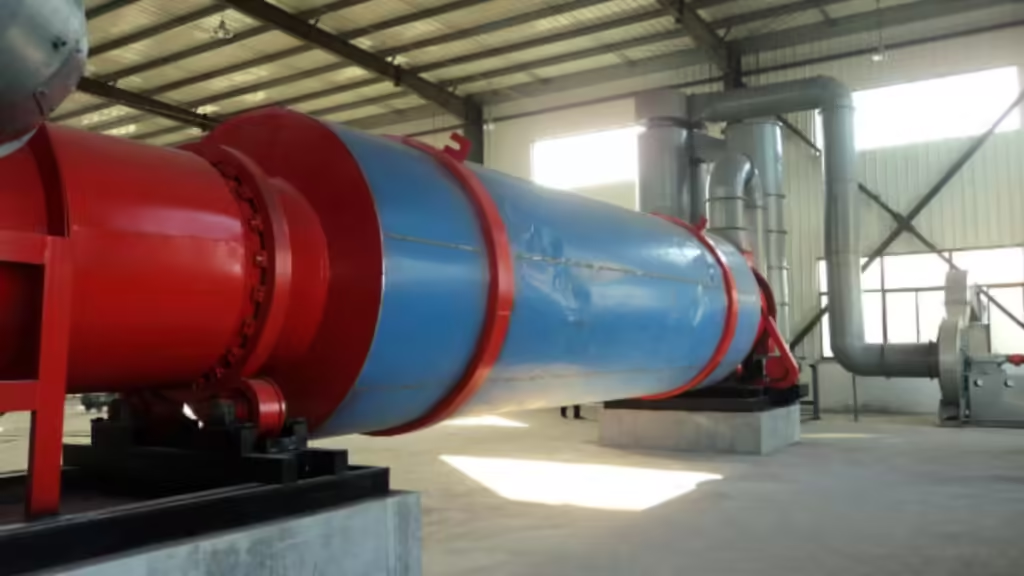
4. Drying the Wood Chips
Suppose a pellet mill employs freshly cut raw material, material exposed to the elements or high humidity, or a mixture of raw materials that may retain moisture. In that case, the sawdust must be dried to a constant moisture level. Large dryer drums may use natural gas, propane, sawdust burners, or other fuels to heat the drum and remove excess moisture.
Before entering the pelletisation process, the moisture content of the wood chips must be between 11.5% and 12%. Anything else than this might damage the quality of the pellets produced. Hence, the chips enter a big drum, blasted with hot air created by a heater fuelled by debarking bark. A powerful fan moves the chips through the drum in preparation for the hammer mill.

5. Grinding - Entering the Wood Pellet Hammer Mill
Grinding is required as a further size reduction stage in wood pellet production. During the grinding operation, the raw materials will be put into a hammer mill, which will reduce the size of the raw materials to under 5mm in diameter.
However, the hammer mill can only handle raw wood materials with a diameter of no more than 50mm; hence, wood logs and branches cannot be put directly into the hammer mill; they must be treated by the wood chipper first.
Moreover, a set of hammers are affixed to a rotating shaft inside the hammer mill. The wood chips are subsequently fed into the top of the drum, where they are chipped and shredded by rotating hammers into a fine powder used to manufacture pellets.
6. Pelletisation of the Wood Pellets
Afterwards, the powdered woodchips are introduced into the pellet mill to commence the pelletisation process. A spinning arm forces the powdered wood fibres through a grating with many tiny pores. As the wood fibre goes through the perforations in a metal ring die, the extreme pressure warms it and causes it to bond together, generating compressed wood pellets.
7. Cooling the Pellets
After pelletisation, wood pellets are very vulnerable. It has been repeatedly compressed in the pellet mill, making it hot and easily distorted. Immediately after the pelletisation process, the wood pellets will be put into a pellet chiller to restore their optimum firmness and temperature. There are three varieties of pellet cooler: the horizontal cooler, the vertical cooler, and the counter flow cooler. All of them may be used to chill wood pellets. However, the most sophisticated pellet cooler on the market is the counter flow cooler, which I suggest.
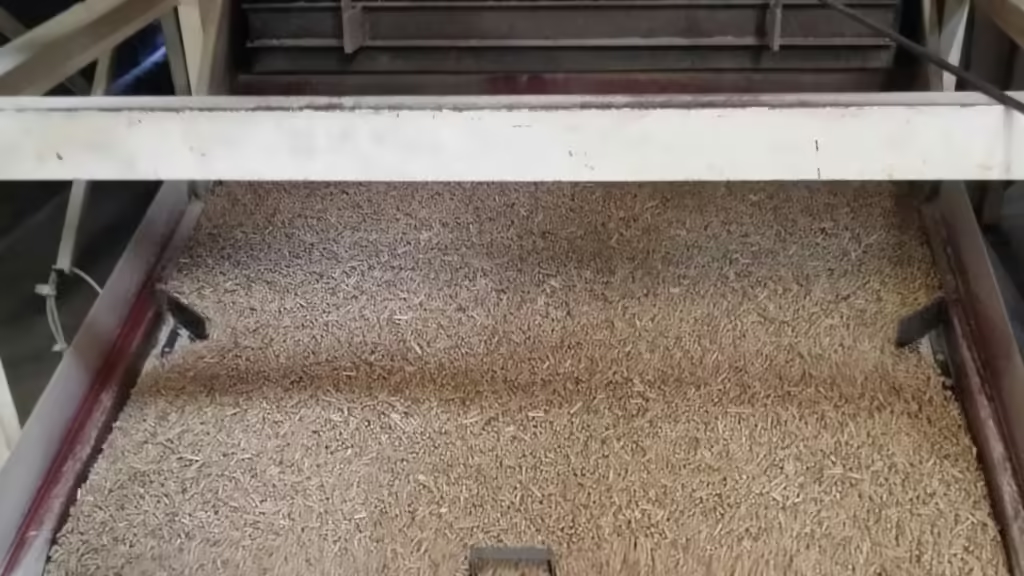
8. Finalising with an Additional Sieving
Lastly, the aim of wood pellet sieving differs from that of the first sifting. This process is unique to commercial wood pellet plants. Since the commercial wood pellet has a stringent restriction on fine content, the wood pellet products will be sieved after pellet cooling to remove the fine particles from the well-made wood pellet.
Bottom Line
For heating purposes, wood pellets emerge as an ecologically beneficial alternative to fossil fuels. Most of the time, they are utilised in biomass boilers to provide household heat and hot water. Moreover, they are also utilised as a zero-carbon fuel for heat-generating and industrial
Join the Club
Join thousands & join our mailing list to keep ahead of our best prices.
Buy Now
Use Payment Methods to split your purchase into interest-free installments.
Award Winning Service
White Horse Energy has won the Feefo Platinum Service Award
Can we help?
Get to our customer support send us a message there.
Join the Club
Join thousands of other members and get the latest deals and offers.
Contact Us
Join the Club
Join thousands of other members and get the latest deals and offers.
